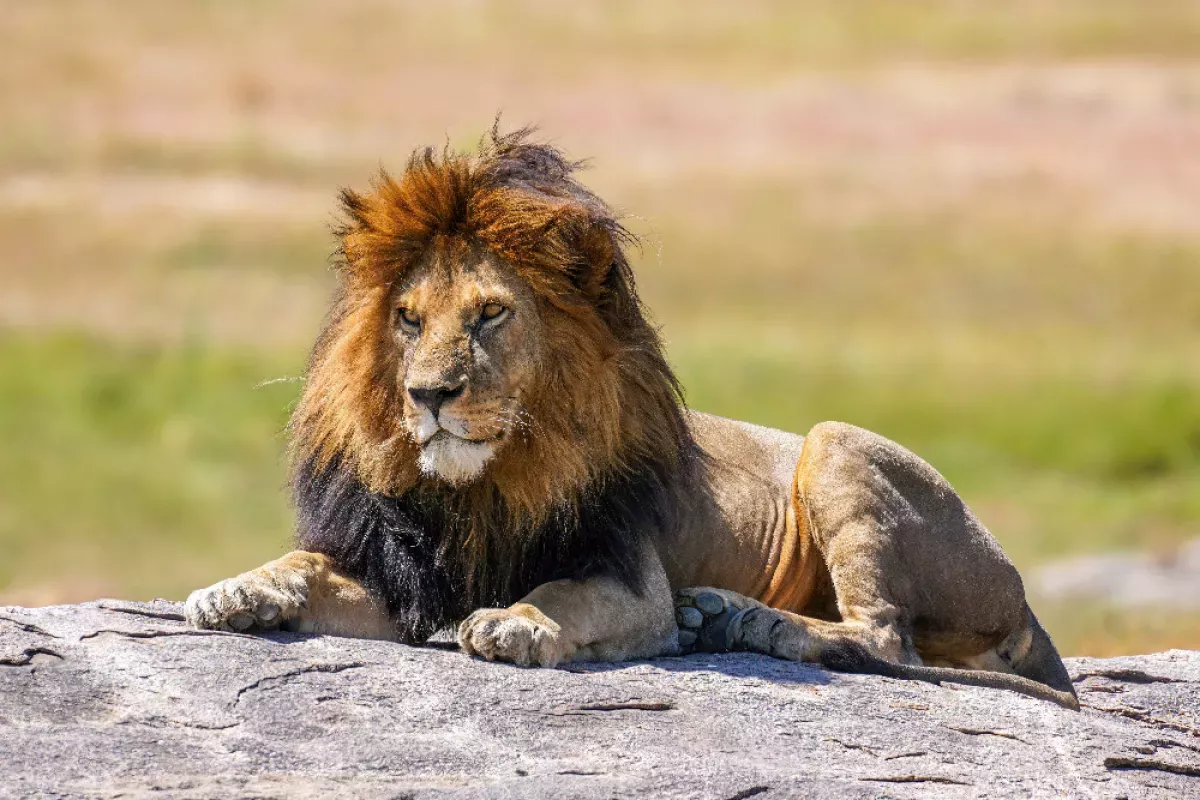The lion (Panthera leo) is a large cat species native to Africa and India, known for its muscular build, short head, and distinctive tail tuft. Lions exhibit sexual dimorphism, with males being larger and possessing a mane. They are social animals living in prides consisting of a few adult males, related females, and their cubs. Female lions typically hunt in groups, preying on ungulates. As an apex and keystone predator, lions play a crucial role in their ecosystem.
1900: Publication of The Wonderful Wizard of Oz
In 1900, L. Frank Baum's "The Wonderful Wizard of Oz" was published, featuring the Cowardly Lion, contributing to the lion's continued presence in modern literature.
1903: Clyde Beatty's Birth Year
American Clyde Beatty, who possibly first used the now-iconic lion tamer's chair, was born in 1903.
1942: Last Live Lion Sighted in Iran
In 1942, the last live lion in Iran was sighted about 65 km northwest of Dezful.
1944: Corpse of Lioness Found in Iran
In 1944, the corpse of a lioness was found on the banks of the Karun river in Khuzestan province, Iran.
1962: Stable Fly Outbreak in Ngorongoro Crater
In 1962, an outbreak of stable flies in the Ngorongoro Crater afflicted lions, causing emaciation and the local population dropped from 70 to 15 individuals.
1965: Clyde Beatty's Death Year
American Clyde Beatty, who possibly first used the now-iconic lion tamer's chair, died in 1965.
1974: Asiatic Lion Population
In 1974, the Asiatic lion population in Gir National Park, India, was approximately 180.
1975: Lion Number Decline
In 1975, it was estimated that since the 1950s, lion numbers had decreased by half to 200,000 or fewer.
1982: Species Survival Plan for Asiatic Lions Started
In 1982, the Association of Zoos and Aquariums started a Species Survival Plan for the Asiatic lion to increase its chances of survival.
1987: Lions Killing Cheetah Cubs
A study in the Serengeti ecosystem revealed that lions killed at least 17 of 125 cheetah cubs born between 1987 and 1990.
1987: Hybrid Lions in North American Zoos
In 1987, it was found that most lions in North American zoos were hybrids between African and Asiatic lions.
1988: Lion Attack Study Begins
In 1988, a study began tracking 1,000 people attacked by lions in southern Tanzania to understand patterns and causes of the attacks, with data collection continuing until 2009.
1989: Wild-born Lions Imported to American Zoos
Wild-born lions were imported to American zoos from Africa between 1989 and 1995.
1990: Lions Killing Cheetah Cubs
A study in the Serengeti ecosystem revealed that lions killed at least 17 of 125 cheetah cubs born between 1987 and 1990.
1990: Increase in Man-Eating Behavior
In 1990, reports indicated a significant increase in man-eating behavior by lions in rural Tanzania. This rise in attacks continued until 2005.
1994: Release of The Lion King
In 1994, Disney released the animated feature film "The Lion King", portraying the lion as the ruler of animals, significantly impacting popular culture.
1994: Canine Distemper Outbreak in Serengeti
In 1994, a canine distemper virus outbreak in Serengeti National Park resulted in many lions developing neurological symptoms, with several deaths from pneumonia and encephalitis.
1995: Wild-born Lions Imported to American Zoos
Wild-born lions were imported to American zoos from Africa between 1989 and 1995.
1996: IUCN Red List Status
In 1996, the lion was listed as Vulnerable on the IUCN Red List due to a 43% population decline in African countries since the early 1990s. Habitat loss and human conflicts are major concerns.
1998: Breeding Continued Under African Lion Species Survival Plan
Breeding of lions was continued in 1998 in the frame of an African lion Species Survival Plan.
2001: Stable Fly Outbreak in Ngorongoro Crater
In 2001, a more recent outbreak of stable flies in the Ngorongoro Crater killed six lions.
2002: African Lion Population Estimate
Estimates of the African lion population range between 16,500 and 47,000 living in the wild in 2002–2004.
2004: African Lion Population Estimate
Estimates of the African lion population range between 16,500 and 47,000 living in the wild in 2002–2004.
2005: Peak of Lion Attacks in Tanzania
By 2005, lion attacks on villagers in Tanzania had risen considerably since 1990, resulting in at least 563 villagers being attacked near the Selous Game Reserve and Lindi Region.
2005: Lion Conservation Strategies Developed
In 2005, Lion Conservation Strategies were developed for West and Central Africa, and East and Southern Africa, to maintain habitat, ensure wild prey, and reduce population fragmentation.
2005: Lion Subspecies Recognition
In 2005, of the 26 lion specimens described between the mid-18th and mid-20th centuries, 11 were recognised as valid subspecies. These were distinguished mostly by the size and colour of their manes and skins.
2006: Captive Lions of Unknown Origin
About 77% of the captive lions registered in the International Species Information System in 2006 were of unknown origin.
2007: White Lion Births Recorded
Between 2007 and 2015, 17 white lion births were recorded in five prides in and around Kruger National Park and the Timbavati Private Game Reserve.
2007: Lion Longevity in Captivity
In 2007, three sibling lions at the Honolulu Zoo lived to the age of 22, demonstrating lion longevity in captivity.
2008: IUCN Red List Subspecies Names
Between 2008 and 2016, IUCN Red List assessors used only two subspecific names: P. l. leo for African lion populations, and P. l. persica for the Asiatic lion population.
2008: Asiatic Lion Listed as Endangered
Since 2008, the Asiatic lion has been listed as Endangered on the IUCN Red List.
2009: Lion Population in Waza National Park
As of 2009, approximately 14 to 21 lions persisted in Cameroon's Waza National Park.
2009: Completion of Lion Attack Study
In 2009, a study of 1,000 people attacked by lions in southern Tanzania between 1988 and 2009, concluded, revealing increased night-time attacks following the full moon due to reduced moonlight.
2010: Asiatic Lion Population
By 2010, the Asiatic lion population in Gir National Park and surrounding areas had risen to about 400.
2014: Local Extinction in Odzala-Kokoua National Park
By 2014, no lions were recorded in the Odzala-Kokoua National Park in the Republic of the Congo, indicating the population is considered locally extinct.
2015: White Lion Births Recorded
Between 2007 and 2015, 17 white lion births were recorded in five prides in and around Kruger National Park and the Timbavati Private Game Reserve.
2015: Asiatic Lion Population Growth
By 2015, the Asiatic lion population had grown to 523 individuals inhabiting an area of 7,000 square kilometers in Saurashtra.
2015: Lion Sightings in Ghana and Ethiopia
In 2015, an adult male lion and a female lion were sighted in Ghana's Mole National Park after 39 years. Also in the same year, a population of up to 200 lions was filmed in the Alatash National Park, Ethiopia.
2015: West African Lion Population Estimate
In 2015, it was estimated that the West African lion population consists of about 400 animals, including fewer than 250 mature individuals, and is listed as Critically Endangered.
2015: Killing of Cecil the Lion
Trophy hunting of lions in recent years has been met with controversy, notably with the killing of Cecil the lion in mid-2015.
2016: IUCN Red List Subspecies Names
Between 2008 and 2016, IUCN Red List assessors used only two subspecific names: P. l. leo for African lion populations, and P. l. persica for the Asiatic lion population.
2017: Asiatic Lion Census
In 2017, about 650 Asiatic lions were recorded during the Asiatic Lion Census.
2017: Lion Taxonomy Revision
In 2017, the Cat Classification Task Force of the Cat Specialist Group revised lion taxonomy, recognising two subspecies based on phylogeographic studies on lion evolution.
2018: Lion Running Speed Study
A study in 2018 recorded a lion running at a top speed of 74.1 km/h, accelerating at 9.5 m/s at the start of the chase. Acceleration appears to be more important than steady displacement speed in lion hunts.
Mentioned in this timeline
India officially the Republic of India is a South Asian...
Africa is the second-largest and second-most populous continent comprising of...
Tanzania officially the United Republic of Tanzania is an East...

The domestic cat is a small domesticated carnivorous mammal and...

A full moon is a lunar phase occurring monthly when...
Ghana officially the Republic of Ghana is a West African...
Trending

John Stamos is an American actor and musician who rose to fame as Blackie Parrish on General Hospital earning a...

8 months ago Austin Hays emerges as a top Fantasy Baseball Waiver Wire pickup.

1 month ago Maxxine Dupri, assisted by AJ Lee, dethrones Becky Lynch for Intercontinental Title on Raw!

7 months ago Kiefer Sutherland and Rebel Wilson star in 'Tinsel Town'; First Look Released!
26 days ago Republic Services Donates Turkeys Across Tennessee for Holidays, Helping Families in Need

Chick-fil-A is a prominent American fast food chain known for its chicken sandwiches With headquarters in College Park Georgia they...
Popular

Tucker Carlson is an American conservative political commentator known for...

XXXTentacion born Jahseh Dwayne Ricardo Onfroy was a controversial yet...

Ben Shapiro is a prominent American conservative political commentator media...

Candace Owens is an American conservative political commentator and author...

William Franklin Graham III commonly known as Franklin Graham is...

Ursula Gertrud von der Leyen is a prominent German politician...
